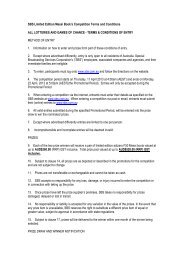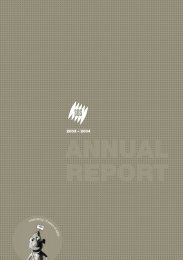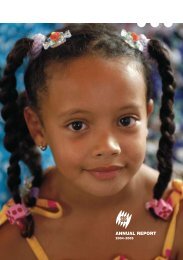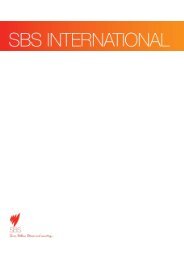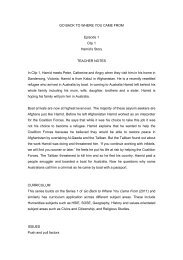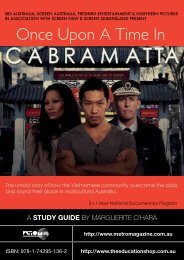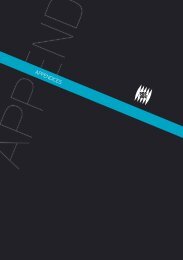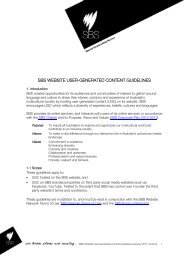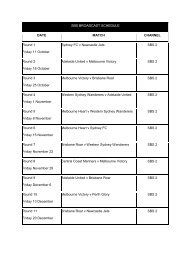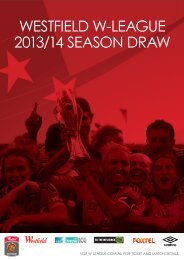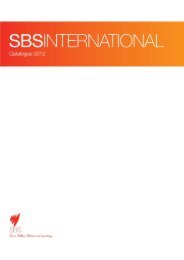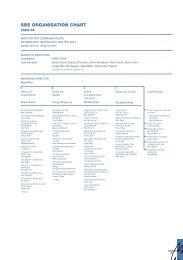AnnuAl REPORT 2011-2012 - Sbs
AnnuAl REPORT 2011-2012 - Sbs
AnnuAl REPORT 2011-2012 - Sbs
- TAGS
- annual
- media.sbs.com.au
Create successful ePaper yourself
Turn your PDF publications into a flip-book with our unique Google optimized e-Paper software.
Depreciation and amortisation rates applying to each class of depreciable asset are based on the following useful lives:<br />
CLAss oF NoN FINANCIAL Asset <strong>2011</strong>-<strong>2012</strong> AVG 2010-<strong>2011</strong> AVG<br />
Buildings 40 years 40 40 years 40<br />
Leasehold improvements Lease term 15 Lease term 15<br />
Plant and equipment 3 to 20 years 7 3 to 20 years 7<br />
Intangibles (excluding goodwill and trademark) 5 to 7 years 6 5 to 7 years 6<br />
The aggregate amount of depreciation allocated for each<br />
class of asset during the reporting period is disclosed in<br />
Note 3(c).<br />
Leasehold improvements are amortised on a straight line<br />
basis over the shorter of either the unexpired period of the<br />
lease or the estimated useful life of the improvements.<br />
Intangible assets (computer software and contract rights)<br />
are amortised on a straight line basis over their estimated<br />
useful lives. Goodwill and trademark are not amortised,<br />
but tested for impairment.<br />
(t) Impairment of non-current assets<br />
All assets are reviewed for impairment as at 30 June <strong>2012</strong>.<br />
Where impairment testing is required (e.g. goodwill) or<br />
indications of impairment exist, the asset’s recoverable<br />
amount is estimated, and an impairment adjustment<br />
made if the asset’s recoverable amount is less than its<br />
carrying amount. The recoverable amount is the higher of<br />
its fair value less costs to sell and its “value in use”. “Value<br />
in use” is assessed as the “depreciated replacement cost”<br />
if the future economic benefit of the asset is not primarily<br />
dependent on the asset’s ability to generate cash flows,<br />
and the asset would be replaced by the Corporation<br />
if deprived of the asset. For the purposes of goodwill<br />
impairment testing, a “cash-generating unit” (CGU),<br />
comprising the smallest group of assets to which goodwill<br />
can be allocated, is identified and tested for impairment<br />
as a group – see Note 8(c).<br />
In <strong>2012</strong>, after writing off a number of assets identified as<br />
obsolete and/or disposed, no indicators of impairment<br />
were found for the remaining Corporation’s assets (at fair<br />
value or at cost) – see Note 3(e).<br />
(u) program inventory<br />
Program costs are capitalised as inventory and amortised<br />
over time to reflect their expected usage:<br />
Program acquisitions<br />
Program acquisitions are generally amortised on a straight<br />
line basis over the shorter of three years or licence period<br />
(for movies), or over the shorter period of two years or<br />
licence period (for documentaries and other overseas<br />
purchased programs).<br />
Commissioned programs<br />
Commissioned programs are valued at cost, and generally<br />
amortised on a straight line basis over the shorter of four<br />
years or licence period.<br />
Some programs are fully amortised in the current period.<br />
All internally produced news and current affairs programs,<br />
as well as sports events, are expensed immediately at the<br />
time of broadcast.<br />
(v) Investment in associates<br />
The Corporation’s investments in its associates are<br />
accounted for using the equity method.<br />
Under the equity method, investments in the associates<br />
are carried in the Corporation’s balance sheet at cost as<br />
adjusted for post-acquisition charges in the Corporation’s<br />
share of net assets of the associates. Goodwill relating<br />
to an associate is included in the carrying amount of the<br />
investment. After the application of the equity method,<br />
the Corporation determines whether it is necessary to<br />
recognise any impairment loss with respect to the net<br />
investment in associates.<br />
Further details relating to its associate company, Freeview<br />
Australia Ltd, are provided in Note 7(d)(ii).<br />
<strong>AnnuAl</strong> RepoRt <strong>2011</strong> – <strong>2012</strong> 85



